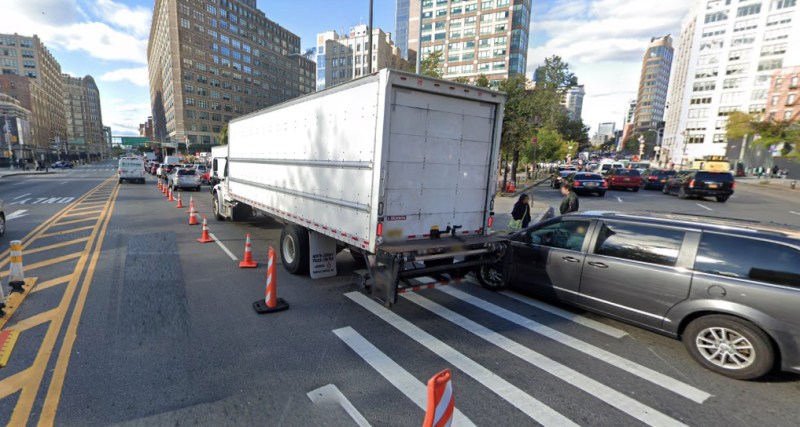Zone of Hope? DOT to Undertake Tiny Canal Street Improvements

It’s one small step for steppers and, perhaps, a slightly less small leap for humankind.
The Department of Transportation quietly revealed on Monday that it will soon launch a “pedestrian safety” project on a short stretch of Canal Street — a small beginning to what advocates hope will culminate decades of campaigns with a full redesign.
Per the agency’s tweet, the stretch between Hudson Street and Sixth Avenue will get two curb extensions (and lose one!), and, perhaps most important, a diversion of Jersey-bound buses from the congested intersection of Sixth Avenue and Watts Street to the (also congested) Holland Tunnel mouth on Canal via a short dedicated bus lane.
In June/July 2022, NYC DOT will begin pedestrian safety improvements on Canal St from Hudson St to 6th Ave in #Manhattan. This work will:
?Increase safety
????Shorten pedestrians crossings
?Improve bus speeds
?Reduce congestions pic.twitter.com/e4IV7AyYYa— NYC DOT (@NYC_DOT) June 13, 2022
It’s unclear whether this will solve the epic congestion of the Greater Hudson Square region — traffic that has been so eloquently documented by filmmakers, activists and the DOT itself in last year’s Hudson Square/West Village Transportation Study.
That report, the fruit of more than two years of community meetings and analysis, recommended re-routing buses away from Sixth Avenue and onto Canal, as well as the curb extensions. But the report also makes it clear that Jersey-bound buses are caught in traffic that backs up at both the Watts Street and the Canal Street tunnel maws. The advantage of having the buses stay on Canal comes from giving buses a wider turn; on Watts Street, the tight left turn sometimes exacerbates traffic.
Activists who have been championing a redesign of Canal were completely and utterly underwhelmed.
“While we applaud progress, the community deserves more,” said Paul Monnes of Transportation Alternatives’s much broader #FixCanal campaign. “It’s heartening that DOT is finally getting started. But this is just one segment of a dangerous road that needs a true end-to-end redesign.”
Monnes alluded to the agency’s March workshop, when several participants pointed out how “inhospitable” Canal remains for pedestrians between Sixth Avenue and Hudson Street.
“Community members requested changes like curb extensions, crossing islands, leading pedestrian intervals,” Monnes said. “However, the plan to add just two extensions — and remove one on Varick — is disappointing.”
On the plus side, the DOT said the initial work next month is only just the beginning.
Spokesman Vin Barone called the improvements “a project to improve safety and bus speeds by the tunnel,” but hastened to add that there will be more work done in that area and, “The broader corridor vision [of all of Canal] is ongoing.”
“This work is happening on and around Canal Street [but] it is nowhere near the full improvements we hope to bring to the corridor as part of our larger Canal Street Pedestrian Improvement Study, which is just getting started,” he said.
The city is under intense pressure to make Canal Street safer. Both Varick Street and Canal and Sixth Avenue and Canal have been dubbed “high crash locations” and “Vision Zero priority corridors” by the DOT, thanks to the number of crashes and injuries in those areas.
In just the tiny area bounded by Varick and Sixth avenues and Watts and Canal streets, there have been 609 reported crashes since 2018, injuring 24 cyclists, 24 pedestrians and 92 motorists. Varick and Sixth avenues both lack protected bike lanes — or even painted lanes — as cyclists approach and leave the Canal zone. All three roadways are truck routes.
Judging from the DOT flier, the agency will create a dedicated bus-only right turn on Canal into the tunnel that appeared in the Hudson Square study and was not admired by at least one activist:
The City proposes to first try a 41 foot (lol) long bus lane instead. Although there are promises to monitor how it affects "traffic" flow, the sig longer proposed dedicated bus lane is already deemed as unfeasible because…it wouldn't move enough private cars down Canal Street. pic.twitter.com/fDtVxT0bi9
— Philip Miatkowski (@miatkowski) November 8, 2021
It is unclear why the DOT did not include protected bike lanes on Varick and Sixth, though one or both were initially considered for such life-saving infrastructure:
A PBL was considered where Varick St has 6 lanes, 1 of which is parking during non PM rush hour. Wish I was joking: DOT decided that there wasn't enough room while offering this image, adding: "This removal of parking/loading would disrupt commercial activities along Varick St." pic.twitter.com/JZhjvhF0PE
— Philip Miatkowski (@miatkowski) November 8, 2021
It is also unclear if these changes will help the M21 bus, which became famous late in the de Blasio administration when more and more reporters noticed that the bus rarely makes it to the western end of its route because of epic traffic that requires bus drivers to truncate their runs and dismiss their passengers blocks before the terminus.
The MTA often has to send out tweets like this:
M21 bus service is suspended west of Varick St because of heavy traffic entering the Holland Tunnel. Buses will end/begin at Sixth Ave/Spring St. pic.twitter.com/zLz0rPXHpK
— NYCT Bus (@NYCTBus) September 24, 2021
The 950 feet of minor pedestrian and bus improvements has been a decade in the making. In 2011, for example, Streetsblog covered an earlier effort to make Canal safer — and the outlet’s story included a reference to a 2002 effort to do the same. The now 11-year-old article made it clear that very little has been done to mitigate Canal’s deleterious effect on residents and on commuters.





